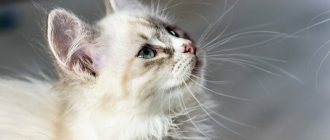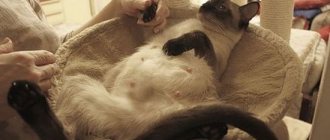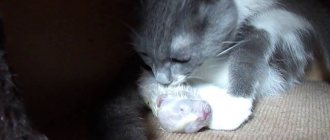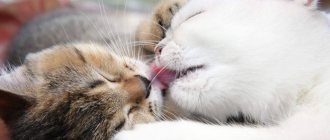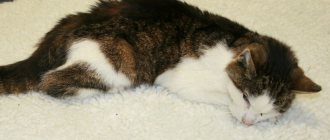Reproduction is no less important a natural process in the life of animals than, for example, nutrition or growth. While protecting the health of their beloved pet, owners often face the problem of continuing the cat family. At the same time, when the animal is about to give birth, the whole family panics, because what to do if the cat needs help?
Normal pregnancy process, stages and timing
In a healthy animal, the process of pregnancy and childbirth occurs without the need for intervention or assistance.
In purebred, small, problem cats, childbirth may occur with complications. In more developed countries, there is a special profession - zooobstetrician, a specialist responsible for the favorable course of childbirth, preserving the life and health of the mother and offspring. In “our realities,” all responsibility falls on the shoulders of the owners and general veterinarians. On average, a normal cat pregnancy lasts 60–65 days, but the period can vary by 7–10 days depending on the breed and body composition of the expectant mother. Conventionally, pregnancy is divided into 3 stages:
- Mating – 3 weeks: after mating, the cat experiences swelling of the mucous membranes of the genital tract, but this does not guarantee pregnancy. Clear signs are observed from the third week: Drowsiness, decreased appetite and activity.
- Requires affection and attention.
- Vomiting (no more than 3 times a day, no longer than 2-3 days).
- Distinct pigmentation of the mammary glands - from light to bright pink.
- An enlarged uterus, which can be detected by a veterinarian by palpation.
- 4-6 weeks: Rapid growth of the “babies” and “rounding” of the cat. By week 6, the amount of fluid in the uterus increases, and the kittens begin to make their first movements.
- Kittens can be “felt” when gently palpated.
- The cat eats and sleeps more, otherwise behaves as usual.
- 7–9 weeks: Kittens are actively moving. The movements are clearly visible to the naked eye, especially if the cat is sleeping.
- Swelling of the mammary glands, release of colostrum.
- Some cats have a whitish vaginal discharge, which is normal.
- Increased anxiety and making a “den”.
How is the pregnancy period going?
The owner of the cat can calculate in advance the approximate date of labor. Pregnancy in animals lasts about 60-65 days. Full-term kittens are born healthy.
If a cat exhibits pathological signs during pregnancy, there is a chance that labor will begin ahead of schedule. To ensure that your pet bears a healthy litter and her pregnancy does not end tragically, be sure to show the cat to the veterinarian throughout the entire pregnancy. This is especially true if pregnancy occurs with complications.
Childbirth for the first time - features
The behavior of first-time cats is always unpredictable. Many years of experience of breeders and owners have made it possible to identify some patterns of events if a cat gives birth for the first time. Primiparous cats are more emotional in everything: they meow more, caress more, panic more, etc.
Primiparous cats arrange the nest much in advance (1–2 weeks before giving birth), or “forget” about this ritual. Many owners note that 10–12 hours before giving birth, the cat categorically does not let go of its owners and meows loudly if it is left alone.
After giving birth, the behavior of primiparous cats is also unpredictable. A young mother will worry about the safety of her offspring and may carry kittens several times, protect them from annoying attention, and even hide them.
How to prepare a nest for a cat?
A nest is a place where a cat gives birth and raises kittens. Kittens stay there for up to 1-1.5 months. It is best to use a cardboard box without foreign odors as a nest. Boxes of strong-smelling household, paint, and perfume products will cause rejection in the animal.
Boxes of aromatic food products - sausages, cheeses, fish - are also not suitable. Cardboard should not smell like anything.
At the bottom of the box you need to put several waterproof diapers - veterinary, children's or surgical. During the birth process, one or two of them will be wet and soiled with amniotic fluid, mucus, and blood.
Dirty and wet diapers will need to be removed and left clean and dry. It is advisable to keep the diapers that were already at the bottom of the box at the time of birth, since they will retain the smell of the cat, and she will not be nervous about changing the bedding.
Cat houses are not suitable as a nest. It will be difficult to wash them off from mucus and blood. In addition, in the house it is difficult to observe the giving birth and provide assistance to her.
If there is no nest, the cat can settle in the closet on clothes, on the sofa on bed linen or on the kitchen table. Then she will bring the born offspring there, risking the destruction of the litter.
Cat before birth
So, as we have already said, the first signs of impending labor are observed 7-10 days before
From this period, the owner should pay special attention to his cat. If she goes for a walk outside the house, take her from the street and try not to leave her alone for a long time
You can tell that a cat is ready to give birth by the following signs:
- often lie down in a prepared box on your back;
- in the stomach you can visually notice the active movement of kittens;
- the cat begins to actively wash itself, lick the genitals, even to the point of licking off all the fur under the tail;
- a day before giving birth, she is constantly in the birth box, from where she comes out to drink water or milk;
- does not eat anything on the last day before giving birth;
- The animal's genitals become noticeably swollen, and redness of the nipples and skin under the tail is also observed.
Have you noticed these signs in your cat? Then you no longer have to wonder how long it will take for her to give birth. Here everything is already extremely clear - childbirth can take place at any minute within the next 24 hours! Be prepared for this process and purchase everything you need in advance in case complications arise during labor.
How can you tell if your cat has started giving birth? Before giving birth, a mucus plug comes out of the cat’s genitals, then the birth process begins, during which the cat can meow loudly and pitifully. At this moment, the owner should be nearby and calm his pet with gentle stroking and kind words of support.
To make it easier for you to navigate this difficult matter, consult in advance with a veterinarian who will answer all your questions in detail. Childbirth can happen differently for each animal.
For example, ordinary cats that do not have pedigree roots often give birth on their own. The owner may not even notice this process and see already born kittens affectionately eating their mother's milk.
It is impossible to predict how the birth will go. This depends on the individuality of the animal’s body and whether the cat has given birth before. Young individuals bearing offspring for the first time take longer than usual to give birth and often scream loudly. Due to lack of experience, such cats often try to run out of the box, which is not at all recommended.
It is also not advisable to allow rollovers and squats. In such positions, a cat can seriously harm her kittens. To eliminate such risks, the owner needs to control the birth process and prevent such positions of the animal’s body. It is better to carefully turn her on her side and gently stroke her stomach and back. This will calm the frightened mother cat a little.
Even an inexperienced owner will notice that the cat has begun to give birth. The first kitten will emerge from the genitals of the expectant mother. At this moment, the woman in labor will strain and push very hard, thereby trying to quickly push the baby to the light.
The first kitten may be in the amniotic sac, which occurs if it does not burst during birth. The cat will be able to free the baby from the bubble by carefully gnawing the shell.
If this does not happen, take the initiative and free the newborn from the bladder using sterile scissors. When cutting the shell, be extremely careful and attentive so as not to harm the kitten.
How can you tell if your cat is no longer giving birth? The frequency of birth of each kitten is 15-40 minutes. This means that you won’t have to expect a quick birth. After the kitten is born, the placenta emerges from the genitals, which she must eat. This will allow the woman in labor to quickly realize motherhood and speed up the lactation process.
As a rule, the owner does not have to persuade the cat; it eats the placenta by force of natural instinct.
After the placenta is delivered, you can understand that she gave birth to all the kittens and has already finished giving birth. It is very good if the birth was successful for both the mother cat and her offspring. But sometimes complications occur, which we will now talk about!
Preparing for childbirth
Often pets give birth so quietly and carefully that the owner does not even have time to notice any traces of the event. But in case of complications, the pet may need human help, so it is better to find out in advance how to determine that a cat is giving birth and carefully prepare for this event.
By the end of the third trimester of pregnancy, a caring owner should stock up on items and medications that may be useful during childbirth, as well as immediately after it. So, if you are worried about the health of your pet and her future children, you should definitely have on hand at the time of lambing:
- Oxytocin is a drug that stimulates labor in case it is delayed.
- Sterile latex gloves.
- Sterile scissors and thread.
- Antiseptic agents in powder and liquid form intended for animals.
- Zelenka and cotton balls for treating the umbilical cord.
- A special suction, bulb or pipettes to remove fluid from the kitten’s respiratory tract if it begins to choke.
- Clean terry towels for drying kittens.
- Phone veterinarian for urgent consultation.
- Cat milk replacer (she may not get it).
- A durable cardboard box for kittens with low sides (it doesn’t matter whether you buy it at a pet store or make it yourself - the main thing is that the cat can freely “travel” from and to it without disturbing the kittens).
Signs that indicate the onset of labor
1–3 days before the onset of labor, you can understand from the cat’s behavior that this moment will soon come:
- The future tailed mother is actively looking for secluded places, every now and then trying to hide in the closet or behind the sofa. Digs there, trying to build a nest. The pet becomes very affectionate, constantly demands attention, and can sometimes be annoying. It rarely happens that a cat, on the contrary, becomes overly aggressive and hides from its owners. Other symptoms:
- at this time, the loop increases greatly, and clear or light pink discharge is observed;
- the cat begins to lick itself more often;
- There is a loss of appetite up to complete refusal of food.
- When there are a day or a little less left before lambing, the animal’s body temperature drops to 37°C.
- 4–8 hours before lambing, the animal begins to hunch over. This is how the body reacts to training contractions of the uterus. This process causes great anxiety in the pet; she may complain to the owner, seeking his support. But another option is also possible - she will try to hide.
- 4 hours before labor, the mucus plug comes off. It is a small transparent clot, sometimes it can have a yellowish or greenish tint and include small inclusions of brown, which is considered normal. Often the plug comes out during urination or in parts. But this moment may not be noticed in an overly clean animal.
- When the temperature rises to normal—38–39°C—this means that there are about 2 hours left before birth.
Call a veterinarian immediately if:
- a furry pet carries kittens longer than expected;
- the pet experiences fever, vomiting and convulsions;
- bleeding lasts more than 10 minutes and is accompanied by an unpleasant odor.
Premature birth
Sexual infections, physical trauma, and severe stress are some of the main causes of premature lambing. This problem can occur in older cats or in representatives of breeding and selective breeds who are giving birth for the first time.
Be sure to show your pregnant cat to a veterinarian, and before giving birth, agree with him about help if necessary.
If lambing occurs when the gestation period is 51 days or more, the kittens are considered viable and must be fought for their lives. Call your veterinarian immediately. But under no circumstances try to stop contractions in order to postpone labor until a specialist arrives. You will have to deliver the baby yourself.
How to behave with a pet
If this is your first time attending the birth of a family pet, then excitement is a natural process. You must understand that when a furry mother goes into labor, she experiences pain, fear and needs support. Your behavior will largely determine the successful outcome of the case. Even if you don’t really understand how to act, control yourself. Get together and provide all possible assistance:
- Try to ensure that no strangers or curious people gather near the lambing area.
- Apart from the owner, there should be no other people in the cat's field of vision, even if they are family members to whom the cat is accustomed.
- Talk kindly to your pet, show her that you are nearby and will not abandon her in difficult times. Stroke it from top to bottom. Speak kind words.
Your participation will calm the cat before giving birth
How to calculate due date?
For convenience, the cat owner needs to note the mating date of the cat and count 55 days from it. From this day on, you need to carefully look at the animal and note the slightest changes in its behavior or appearance.
The pregnancy of a domestic cat lasts on average 58 days, but prolongation of pregnancy to 65 days is considered normal. Hairless cats (Canadian and Don Sphynxes, Peterbalds) bear offspring for up to 72 days, and this is also a normal variant. At the same time, representatives of short-haired breeds give birth earlier than long-haired ones.
The more kittens in the uterus, the sooner the birth will occur, so if according to ultrasound results there are more than 5 fetuses, they will probably be born on days 55-57, and if less than three, they will remain in the mother’s womb until 63-65 days.
Professional breeders keep a pregnancy calendar for their pets, noting the start of heat, the dates of the main and control matings, the end of the hunt, the appearance of the first signs of pregnancy, dates and results of veterinary ultrasound.
If the cat is free-range and the mating date is unknown, then you should remember when the pet came into heat, as people say, “went on a spree” or began “begging for a cat.”
Mating usually occurs on the 2-3rd day of hunting. Calculations should be made from this date. By the way, if a cat is not a breeding cat, that is, it is not a member of a club, does not take part in exhibitions and does not have permission to breed, then its offspring are considered outbred and will be difficult to adopt.
It is recommended to castrate such cats in order to avoid exhaustion of the body during childbirth and in order to control the number of outbred and stray animals. Pregnancy is not a contraindication for castration. The animal easily tolerates veterinary surgery even in the last weeks of pregnancy.
How can a person help a giving birth cat?
If a cat, on the eve of lambing, has burrowed away from you in a far, secret corner, there is no need to disturb her. Just be prepared to quickly come to the rescue if trouble arises. But when your pet is nervous and doesn’t leave your side, she definitely wants help immediately.
In this case, you should definitely calm her down and caress her. Don't let your cat squat: this could harm her babies. Try to lay her down on her side by cuddling her and encouraging her with warm words. In addition, you can stimulate labor yourself by stroking your tummy and spine. When your pet pushes, allow her to rest her hind legs on your hand. Always keep clean, warm water on hand: an exhausted woman in labor will often experience increased thirst.
How can you tell if your cat is about to give birth?
How can you tell if your cat is about to give birth? This question is asked by any owner of a pregnant cat. Indeed, it is important to know that the cat is giving birth in order to have time to come to her aid and call a veterinarian in time in case of complications or a pathological course of labor.
Also, the presence of a person next to the cat giving birth for the first time is important. After all, young mothers, due to inexperience, often do not help the kittens breathe and do not lick them. Then the owner’s task is to clear the cubs’ airways from the amniotic membrane and wipe them with a damp cloth from mucus and blood.
What to do if not all kittens are born
Childbirth must be monitored at all stages. This is due to the fact that not all kittens may appear, and labor has already ceased. What to do in such a situation?
The answer is clear - you need to monitor the cat’s behavior for some time and be sure to pay attention to the following points that may cause any suspicion:
- the cat’s behavior changes dramatically, and she begins to behave very strangely;
- if, when palpating your pet’s belly, you feel a kitten in it;
- if the stomach does not differ in size from what it was before childbirth;
- an increased temperature is observed;
- fluid of an uncharacteristic green hue is released from the vagina.
However, a situation may arise when there is absolutely no need to worry. In this case, the cat simply decided to rest and during this period of time lick the babies that had already been born, after which labor resumes again. In this case, there is absolutely no reason to worry and everything is going right.
“But, if labor has stopped, and there are still unborn kittens in the womb of the pet, then in this case you need to urgently call a veterinarian or take your cat to him. Here the owner’s reaction must be very rapid, since the health and life of his pet depends on it.”
Thus, having considered all the nuances of labor in cats, it is worth summing up that the fact that a cat began to give birth is not at all difficult to understand. This process will certainly be indicated by changes in the pet’s behavior. The main rule is to constantly be nearby and closely monitor her, only then you will not miss the moment when the cat may need your help and timely intervention. In most cases, she can handle everything on her own.
The birth process
Kittens ready to be born line up to be born in the animal’s two-horned uterus. The birth process is divided into 3 stages:
- The cat feels contractions of the uterus and at the same time the urge to have a bowel movement. The cervix begins to open slightly. Often at this stage the birth plug comes out along with mucous secretions.
- In the second phase, contractions become more intense and painful, the cervix opens completely, preparing to let the kittens move through the birth canal. The cat strains, trying with all her might to “push through” the cubs. This is how a healthy kitten is born with a favorable course of labor. If the amniotic sac has not burst earlier, the baby is born in it. Usually the woman in labor frees the kitten herself by gnawing the shell. But it happens that she leaves the place of birth in fright or gets lost during the first lambing, and then you must come to the rescue by cutting the bladder with sterile scissors so that the baby does not suffocate. The next cub should emerge 15, maximum 40 minutes after the first.
- At the final stage of labor, the placenta is separated from the mother. The cat must eat one of the nursery places - this will help her quickly realize that she is a mother and speed up lactation. Make sure that after each kitten there is an afterbirth. The placenta remaining in the pet’s body can rot, which will lead to severe inflammation and even death of the animal. At the same time, the cat may eat a stillborn or too weak kitten, which is best avoided.
Alarming symptoms
An unqualified owner cannot always help a furry pet. That is why during childbirth you should have the telephone number of the treating veterinarian, or preferably two or three numbers, at hand. Four symptoms are a serious reason to contact a specialist.
Ahead of schedule. Most often, premature birth occurs in a cat due to a frozen pregnancy, non-viability of the offspring, placental abruption, or trauma. The stages of labor pass faster already on the 50-55th day, sometimes earlier. Most often, a cat gives birth to dead kittens. The living premature offspring dies in the coming days. It happens that a cat gives birth to just one dead baby prematurely. The rest emerge alive and healthy on time. If your cat gives birth prematurely, have her examined by a specialist to understand further steps.
Lack of childbirth. If the pet does not give birth for more than 70 days and if this is not a false “birth” due to an imaginary pregnancy in the cat, then the pregnancy is probably frozen. The cubs most likely died, so it is urgent to save the pet from possible infections and damage to the uterus.
Missed birth
It is important to determine when labor is truly over. If the pushing has stopped and the cat is resting, this does not guarantee that all the kittens will come out.
You should observe your mother's behavior. A cat that has not yet given birth reluctantly takes care of the cubs, does not leave the “nest” and does not change position, refuses to drink, and periodically strains. To make sure, you can feel the stomach three to four hours after birth. The elasticity and tension of the muscles indicate that there is still a kitten left in the womb.
Discharge. Any colored, pungent-smelling discharge during pregnancy and childbirth is a deviation from the norm. During strong, long contractions (more than an hour) without subsequent labor, blood may flow profusely. In this case, it is also necessary to show the cat to a specialist.
Fetal pathologies do not always depend on the health of the mother and can be inherited from the father. However, the physical and mental condition of the cat affects the successful outcome of the birth.
Therefore, it is important that the pet is healthy before mating. Unfavorable factors for childbirth are old age, obesity, stress, and heredity.
Even the process of childbirth in a cat, supported by instincts, does not always go smoothly. You should mentally prepare for any outcome. However, do not panic prematurely and do not intervene without reason. Nervousness will be transferred to the pet, and during childbirth she will be confused. Rest assured that everything will go well and the cat will be able to rely on its owner.
What to prepare?
The first signs of labor in a cat do not come as a surprise. The responsible owner will begin preparations at least a day before labor. There are two options for delivery: at home or in a clinic under the supervision of a veterinarian. The chosen place for birth in a hospital does not require special preparation. Symptoms of contractions or the pushing themselves provoke an immediate trip to the doctor. When a cat has given birth, it is enough to ensure maximum peace and favorable conditions for the nursing pet.
Giving birth to a cat at home involves a thorough preparatory process. To know more about the course and stages, it is recommended to consult a veterinarian. The doctor makes a list of medications that may be useful and assesses the general condition of the animal. Possible medications include injections that can stimulate and speed up labor or pain-relieving injections. In addition to the medication component, it is recommended to prepare a place for childbirth at home, which will have sheets and a warm corner for the babies. Gloves are appropriate and sterilized cord threads should be prepared in advance.
Changes in cat behavior
At the beginning of pregnancy, it is almost impossible to recognize the interesting position of the cat. The appetite changes: the animal begins to eat a little more or a little less. Also, the animal's sleep time increases. Experts note that cats are characterized by excessive affection and a reverent attitude towards their owner. They are more willing to let themselves be petted. This is a manifestation of simultaneous motherhood and character change.
A female cat may suddenly develop an appetite and persistently ask for food from her owner. And it’s better not to make her nervous and hungry. During pregnancy, the belly grows, the animal begins to show increased attention to its hygiene, licking itself more often. Also, behavior is characterized by caution and restlessness. If the cat has been walking outside, then during pregnancy she will limit herself to such walks.
When approaching before giving birth, she begins to purr pitifully, licks the household, as if showing care: from the owners and close guests to other animals in the house. This is a manifestation of maternal instinct. A pregnant cat screams during childbirth and when contractions occur.
When should you contact a veterinarian?
How to determine that labor has been prolonged, has taken a pathological form, and the animal needs help?
It is necessary to call a doctor at home or take a giving birth animal to him if:
- More than 24 hours have passed since the start of labor, and not all kittens were born during this time.
- The attempts are strong and frequent, and the kitten does not leave the birth canal for more than half an hour.
- The second stage of labor lasts more than 12 hours.
- There is profuse bleeding, green, brown, yellow discharge with an unpleasant odor.
- Not all placentas were born.
- The cat is unconscious.
Under no circumstances should you follow the advice of those who do not have a veterinary or at least zootechnical education, or are not a professional cat breeder.
Sometimes ignorant people give advice that is monstrous in its stupidity, and the owners, losing their heads with excitement for their pet, follow them:
- You cannot inject the hormone oxytocin to stimulate labor. Severe contractions after the injection often lead to uterine rupture and the death of the cat from bleeding.
- No-shpa should not be administered to relax the cervix. It often leads to paresis of the hind limbs, that is, to a violation of their motor function - paralysis. The nature of this pathology is neurological and difficult to eliminate. The animal may remain permanently disabled or will have to be treated by a veterinarian for a long time.
- You should not give your cat vodka either as an anesthetic or as anything else. Alcohol is a strong toxin, poison for animals!
- Do not put pressure on the stomach, pull the kitten by the head or paws, or expand the cat’s vagina with your fingers or tools. All these manipulations can lead to rupture of the birth canal, uterine prolapse, death of the litter and mother due to bleeding and damage to internal organs.
Only a veterinarian can provide real help to the mother and litter. Therefore, instead of experimenting on animals, you need to seek qualified help.
